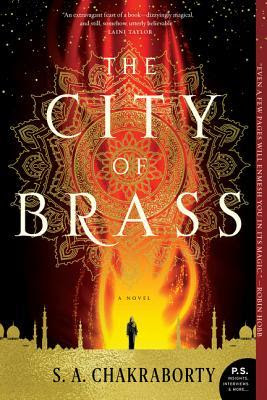 |
| The cover is beautiful! |
I enjoyed this fantasy in a world of djinn and other elements inspired by Middle Eastern and South Asian cultures. I figured it would be a good book to read during Asian American Pacific Islander Heritage Month. While writing this review I discovered that the author is white, and Chakraborty is her married name, so I can't say it has an AAPI author.
Yet this work still delves deeply into the cultures and histories of the Middle East, North Africa, Central Asia, and South Asia, so it makes sense from that angle for AAPI Heritage Month as a nice break from the typical boring and problematic Eurocentrism of the contemporary fantasy genre and its endless paeans to Tolkien. (I also picked up Fonda Lee's Jade City, but I haven't finished it yet. Look for that review coming soon.)
The City of Brass starts out as a sort of historical urban fantasy set in Cairo in the early 19th century, where we meet our first protagonist, Nahri, a con artist with aspirations for a more honest career in medicine. During a con, she accidentally summons a djinn named Dara, who rescues her from malevolent creatures out to kill her.
Then they go to the city of Daevabad, home of the djinn/Daeva people (somewhere in Central Asia, maybe Afghanistan, but the city is magically protected from prying human eyes). Along the way we see some cool things, like water elementals called marid, and our heroes arrive in the city where Nahri is seemingly welcomed as the daughter of a long-lost healer (thus explaining her incipient magical abilities). Dara, it turns out, has a ... complicated past with the people of Daevabad.
We also get POV chapters from Ali, son of the king with hopes of his own for reform and a complicated relationship to his family. Ali took a little longer to grow on me, but I ended up liking him, too.
I'll admit the last half of the book occasionally dragged for me as Chakraborty did some more world building and carefully set up the pieces for things that happen later, and some which I suspect will happen in the sequels. The ending definitely has the feel of a book with sequels (and there are two of them).
One of the more interesting parts of the book for me was getting a sense of how each character relates to and is shaped by their world with its complex histories, factions, and rivalries. We are all shaped by histories and events we had no choice in (what some existentialists call thrownness), but it's still up to you to decide what to do with all that.
An added complication in this book is that few (if any) of the characters have the full story about what's going on and it's rarely clear who, if anyone, is in the right. Instead of providing easy answers, Chakraborty gives further complications, which adds to the depth of the world.
So all-in-all, this was an enjoyable read that is hopefully setting up for something even cooler in the sequels.
No comments:
Post a Comment